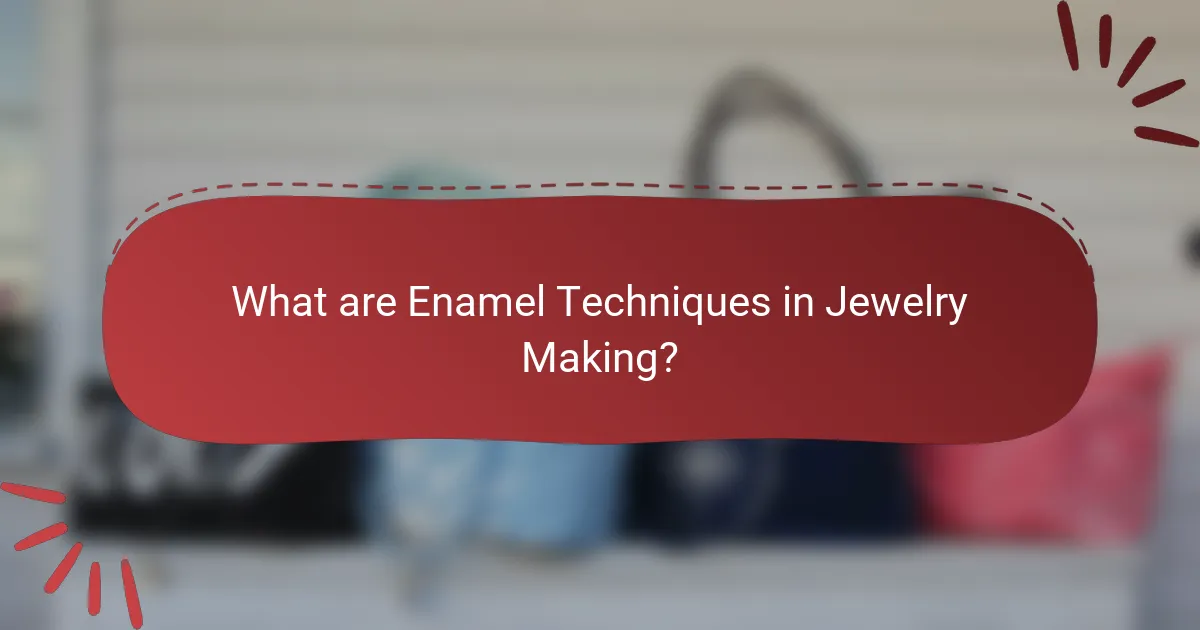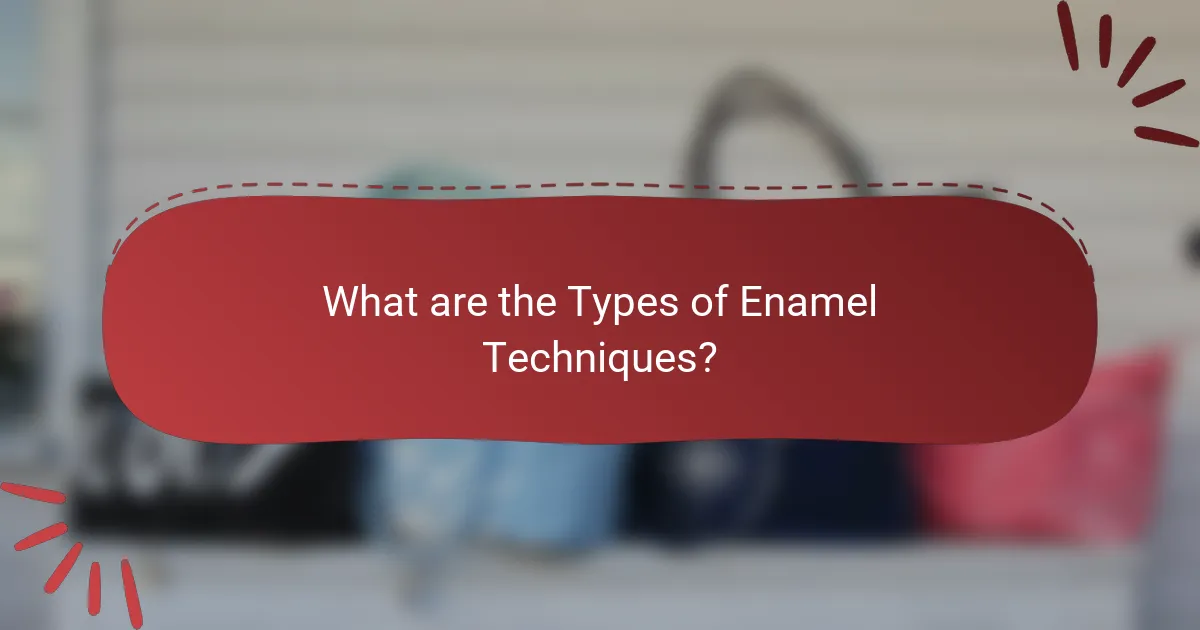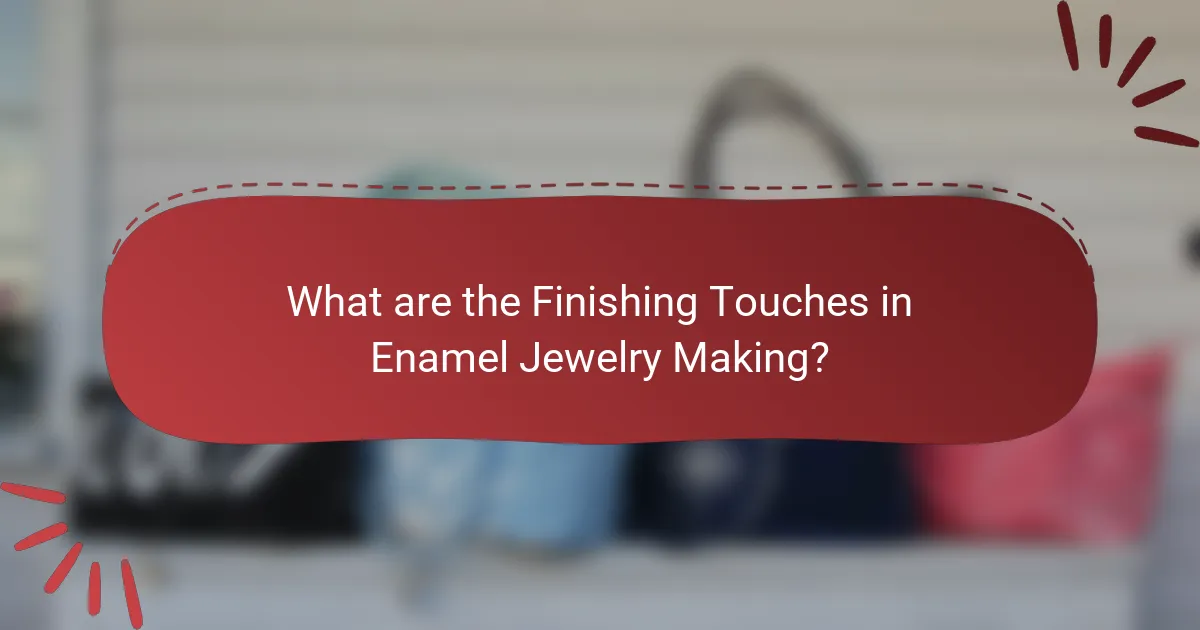Enamel techniques in jewelry making involve the application of glass-like coatings to metal surfaces, enhancing both aesthetic appeal and durability. Key methods include cloisonné, which uses metal strips to create compartments for different colors of enamel; champlevé, which carves recesses in the metal to hold enamel; and basse-taille, which features a low-relief surface to enhance enamel’s translucent quality. The article also covers the application processes of these techniques, including firing in a kiln to fuse enamel to metal, as well as essential finishing touches such as polishing, cleaning, and protective coatings that ensure the longevity and value of enamel jewelry. Historical significance is highlighted, showcasing the enduring nature of these techniques in jewelry craftsmanship.

What are Enamel Techniques in Jewelry Making?
Enamel techniques in jewelry making involve applying glass-like coatings to metal surfaces. These techniques enhance the aesthetic appeal and durability of jewelry pieces. Common methods include cloisonné, champlevé, and enamel painting. Cloisonné uses thin metal strips to create compartments for different colors of enamel. Champlevé involves carving out recesses in the metal to hold the enamel. Enamel painting allows artisans to apply enamel like paint, creating intricate designs. These techniques date back thousands of years, showcasing their historical significance in jewelry craftsmanship.
How do different enamel techniques vary in application?
Different enamel techniques vary in application based on their methods and desired outcomes. Techniques such as cloisonné involve creating compartments with metal wire to hold enamel. This method requires careful placement of wires and multiple firing sessions for layering colors. Champlevé, on the other hand, involves carving or etching the metal surface to create recessed areas for enamel. This technique allows for a more textured finish and often requires less enamel than cloisonné.
Another technique is basse-taille, which uses a textured metal surface to enhance the appearance of translucent enamel. This method emphasizes the underlying design and requires skill in surface preparation. Additionally, plique-à-jour involves creating a stained glass effect by using enamel without a backing. This technique requires precision and is more challenging due to its fragility.
Overall, the application of each technique is influenced by the intended design, the complexity of the process, and the physical properties of the enamel used. Each method has its unique challenges and aesthetic results.
What are the key characteristics of each enamel technique?
Enamel techniques in jewelry making include cloisonné, champlevé, and basse-taille. Cloisonné involves creating compartments with metal wires and filling them with enamel. This technique allows for detailed designs and vibrant colors. Champlevé uses carved or etched metal to create recesses for enamel. It provides a more textured surface and can showcase depth. Basse-taille involves engraving a design into the metal before applying a transparent enamel layer. This technique highlights the engraved pattern through the enamel, creating a unique visual effect. Each technique offers distinct characteristics that influence the final aesthetic of the jewelry piece.
How do the techniques impact the final jewelry design?
The techniques significantly impact the final jewelry design by influencing aesthetics, durability, and functionality. Enamel techniques, such as cloisonné and champlevé, affect color application and surface texture. For instance, cloisonné creates defined compartments for vibrant colors, enhancing visual appeal. Champlevé, on the other hand, allows for a textured surface that adds depth and interest. Additionally, the choice of technique can determine the longevity of the piece. Techniques that create a strong bond between enamel and metal enhance durability. The final design also reflects the artisan’s skill level. Mastery of these techniques can elevate a piece from ordinary to extraordinary.
Why is enamel an important material in jewelry making?
Enamel is an important material in jewelry making due to its vibrant colors and durability. It allows for intricate designs and can be applied to various metals. Enamel is resistant to scratching and fading, ensuring longevity in jewelry pieces. The process of enameling can create a smooth, glass-like finish that enhances the visual appeal of jewelry. Historically, enamel has been used since ancient times, showcasing its enduring popularity. Additionally, enamel can be layered, providing depth and texture to designs. This versatility makes enamel a favored choice among jewelers for both decorative and functional purposes.
What properties make enamel suitable for jewelry?
Enamel is suitable for jewelry due to its durability, vibrant colors, and smooth finish. It is a glass-like material that can withstand wear and tear. Enamel is resistant to scratches and tarnishing, making it ideal for everyday wear. The colors in enamel are achieved through metal oxides, providing a wide range of hues. Enamel can be applied in various techniques, such as cloisonné and champlevé. These methods allow for intricate designs and patterns. Additionally, enamel adheres well to metal surfaces, enhancing the overall aesthetic of the jewelry. The fusion of enamel with metal occurs at high temperatures, creating a strong bond.
How does enamel enhance the aesthetic appeal of jewelry pieces?
Enamel enhances the aesthetic appeal of jewelry pieces by providing vibrant colors and intricate designs. The application of enamel allows for a smooth, glossy finish that catches light beautifully. This technique can create depth and texture, making the jewelry visually striking. Enamel can be applied in various techniques, such as cloisonné or champlevé, each offering unique artistic effects. The durability of enamel ensures that these colors remain vivid over time. Historical examples, such as ancient Egyptian and Byzantine jewelry, showcase enamel’s timeless beauty. Overall, enamel transforms ordinary pieces into stunning works of art.

What are the Types of Enamel Techniques?
There are several types of enamel techniques used in jewelry making. These techniques include cloisonné, champlevé, and basse-taille. Cloisonné involves creating compartments with metal wires to hold different colors of enamel. Champlevé uses carved or etched metal surfaces to create recessed areas for enamel. Basse-taille features a low-relief surface that enhances the translucent quality of the enamel. Each technique provides unique visual effects and applications in jewelry design.
What are the most common types of enamel techniques used in jewelry making?
The most common types of enamel techniques used in jewelry making are cloisonné, champlevé, and basse-taille. Cloisonné involves creating compartments with metal wires and filling them with enamel. This technique allows for intricate designs and vibrant colors. Champlevé uses carved or etched areas in metal to hold enamel, providing a textured appearance. Basse-taille features a low-relief design, where the metal surface is engraved before applying transparent enamel, enhancing the depth of color. These techniques are widely recognized for their aesthetic appeal and craftsmanship in jewelry design.
How is cloisonné enamel applied in jewelry design?
Cloisonné enamel is applied in jewelry design by creating compartments using thin metal wires. These wires are shaped into patterns on a metal base. Once the design is established, enamel powder is placed within the compartments. The piece is then fired in a kiln to fuse the enamel to the metal. This process allows for vibrant colors and intricate designs. Each layer of enamel can be built up for depth and texture. The firing process solidifies the enamel, ensuring durability. Cloisonné enamel techniques date back to ancient civilizations, showcasing its long-standing use in art.
What distinguishes champlevé enamel from other techniques?
Champlevé enamel is distinguished by its method of creating recessed areas in a metal surface to hold enamel. This technique involves carving or etching the metal to form cavities. The enamel is then applied to these cavities before being fired in a kiln. Unlike cloisonné, which uses wire to separate colors, champlevé relies solely on the metal’s surface for color separation. This allows for a more integrated design with the metal base. Historical examples include medieval jewelry, showcasing its long-standing use. The result is often a more textured and dimensional appearance compared to other enameling techniques.
What are the unique attributes of less common enamel techniques?
Less common enamel techniques exhibit unique attributes that differentiate them from traditional methods. One unique technique is cloisonné, characterized by the use of metal wires to create compartments for enamel. Another is champlevé, which involves carving out areas in metal to hold the enamel. Additionally, plique-à-jour is a technique that creates a stained glass effect, allowing light to pass through the transparent enamel. Each of these methods requires specific skills and tools, contributing to their rarity. The historical significance of these techniques is notable, as they have been used in various cultures for centuries, showcasing their artistic value.
How does plique-à-jour differ from traditional enameling methods?
Plique-à-jour differs from traditional enameling methods by allowing light to pass through the enamel. Traditional enameling typically involves a backing that reflects light, creating a different visual effect. Plique-à-jour is characterized by its transparent, stained-glass-like appearance. This technique requires a delicate framework to hold the enamel without support from a backing. The process often involves multiple firings to achieve the desired translucency. In contrast, traditional enameling usually utilizes opaque or semi-opaque enamels. Plique-à-jour is more challenging to execute due to its structural demands. These differences result in unique aesthetic qualities in jewelry pieces.
What is the process of using enamel in mixed media jewelry?
The process of using enamel in mixed media jewelry involves several key steps. First, artists prepare the metal base by cleaning and polishing it. This ensures proper adhesion of the enamel. Next, they apply a layer of enamel powder to the surface. This powder is typically made from glass particles that fuse when heated. The coated piece is then placed in a kiln or torch to melt the enamel. During this heating process, the enamel fuses to the metal, creating a durable finish. After cooling, artists may add additional layers or colors if desired. Finally, the piece is often polished to enhance its shine and detail. This method allows for unique textures and colors, making it popular in contemporary jewelry design.

How are Enamel Techniques Applied in Jewelry Making?
Enamel techniques are applied in jewelry making through processes such as cloisonné, champlevé, and enamel painting. Cloisonné involves creating compartments with metal wires to hold the enamel. Champlevé requires carving out areas in metal to fill with enamel. Enamel painting allows for the application of liquid enamel directly onto metal surfaces. The pieces are then fired in a kiln to fuse the enamel to the metal. This fusion creates a durable and colorful finish. Enamel techniques enhance the aesthetic appeal of jewelry, allowing for intricate designs and vibrant colors. Historical records indicate that these techniques have been used since ancient times, showcasing their longevity and significance in jewelry craftsmanship.
What steps are involved in the application of enamel techniques?
The application of enamel techniques involves several key steps. First, prepare the metal surface by cleaning it thoroughly. This ensures proper adhesion of the enamel. Next, apply a base coat of enamel to create an even foundation. Once the base coat is dry, add additional layers of colored enamel as desired. Each layer must be fired in a kiln to fuse the enamel to the metal. After firing, allow the piece to cool completely. Finally, finish the piece by polishing or adding protective coatings. These steps are essential for achieving a durable and aesthetically pleasing enamel finish in jewelry making.
How do artisans prepare metal surfaces for enameling?
Artisans prepare metal surfaces for enameling by cleaning, sanding, and applying a base coat. First, they clean the metal to remove any dirt, grease, or oxidation. This ensures proper adhesion of the enamel. Next, artisans sand the surface to create a rough texture. This texture helps the enamel bond more effectively. After sanding, a base coat is often applied. This coat can be a clear or colored enamel that enhances the final appearance. The preparation process is crucial for achieving a smooth and durable finish. Properly prepared surfaces result in better enamel application and longevity.
What tools are essential for applying enamel techniques effectively?
Essential tools for applying enamel techniques effectively include a torch, kiln, enamel powders, and sifting tools. A torch provides the necessary heat for techniques like torch firing. A kiln is crucial for larger pieces and consistent heat distribution. Enamel powders come in various colors and are the primary material used in enameling. Sifting tools help apply an even layer of enamel on the metal surface. Other useful tools are brushes for applying liquid enamel and tweezers for handling hot pieces. Each tool plays a vital role in achieving precise and professional enamel applications.
What considerations should be made when choosing an enamel technique?
When choosing an enamel technique, several considerations must be made. The type of enamel being used is crucial. Different techniques require specific enamel types, such as opaque, transparent, or opalescent. The desired finish also plays a significant role. Techniques like cloisonné or champlevé yield different visual effects.
The complexity of the design should be assessed. Some techniques are better suited for intricate designs, while others work well for simpler patterns. The skill level of the artisan is another important factor. Certain techniques may require advanced skills and experience.
The intended use of the jewelry piece should be considered. Items meant for everyday wear may need more durable techniques. Finally, the compatibility with the base metal is essential. Different enamel techniques adhere better to specific metals, impacting overall quality and longevity.
How does the choice of technique influence design decisions?
The choice of technique significantly influences design decisions in jewelry making. Different enamel techniques, such as cloisonné or champlevé, dictate the overall aesthetic and structural integrity of the piece. For instance, cloisonné allows for intricate designs due to its use of metal partitions, while champlevé creates a more textured surface. The selected technique can also affect the color application and layering, impacting the final visual outcome. Additionally, certain techniques may require specific materials or tools, which can limit or expand design possibilities. Historical context shows that artisans often choose techniques based on the desired effect and cultural significance, further guiding design decisions.
What factors affect the durability and longevity of enamel finishes?
The durability and longevity of enamel finishes are affected by several key factors. The quality of the enamel used plays a significant role. High-quality enamel is more resistant to chipping and fading. The application technique also impacts durability. Proper layering and firing temperatures are crucial for a strong bond. Environmental conditions can affect enamel finishes. Exposure to moisture, heat, and chemicals can lead to deterioration. Additionally, the substrate material influences longevity. Certain metals provide better adhesion and protection for enamel. Regular maintenance can enhance the lifespan of enamel finishes. Cleaning with gentle methods prevents wear and preserves appearance.

What are the Finishing Touches in Enamel Jewelry Making?
Finishing touches in enamel jewelry making include polishing, cleaning, and applying protective coatings. Polishing enhances the shine and smoothness of the enamel surface. Cleaning removes any residue from the enameling process. Applying protective coatings, such as clear varnish or resin, shields the enamel from scratches and UV damage. These steps ensure the durability and aesthetic appeal of the finished piece. Proper finishing can significantly increase the value and longevity of enamel jewelry.
What finishing techniques enhance the appearance of enamel jewelry?
Polishing and buffing are essential finishing techniques that enhance the appearance of enamel jewelry. These methods improve the shine and smoothness of the surface. Polishing involves using a fine abrasive to remove any imperfections. Buffing uses a soft cloth or wheel to create a high-gloss finish. Additionally, applying a clear coat can protect the enamel and add depth to the color. This technique helps in achieving a vibrant and long-lasting finish. Finally, careful cleaning with a gentle solution can remove any residues, ensuring the enamel looks its best.
How do polishing and buffing affect the final look of enamel pieces?
Polishing and buffing enhance the final look of enamel pieces by creating a smooth, glossy surface. Polishing removes any surface imperfections and provides a reflective finish. Buffing further enhances this shine by smoothing out the surface with finer abrasives. The combination of these processes results in a vibrant and lustrous appearance. High-quality polishing compounds can increase the depth of color in the enamel. Additionally, proper technique ensures that the enamel remains intact without damage. This careful approach is essential for achieving professional-quality results in jewelry making.
What protective coatings can be applied to enamel jewelry?
Protective coatings that can be applied to enamel jewelry include clear lacquer, epoxy resin, and polyurethane. Clear lacquer provides a thin, transparent layer that shields the enamel from scratches and UV damage. Epoxy resin creates a thick, durable coating that enhances gloss and protects against moisture. Polyurethane offers flexibility and resistance to wear, making it suitable for items that may experience rough handling. These coatings help preserve the vibrancy and integrity of the enamel, extending the jewelry’s lifespan.
What best practices should artisans follow for enamel finishing?
Artisans should follow specific best practices for enamel finishing to ensure high-quality results. First, they must select the right type of enamel for their project. Choosing between opaque, transparent, or opalescent enamel affects the final appearance. Next, proper surface preparation is essential. Cleaning and smoothing the metal surface enhances enamel adhesion.
Additionally, artisans should apply enamel in thin layers. This prevents bubbling and ensures even coverage. Firing the enamel at the correct temperature is crucial. Each enamel type has a recommended firing range for optimal results.
Cooling the piece gradually after firing helps prevent cracking. Artisans should also use a clean workspace to avoid contamination. Finally, finishing touches like polishing enhance the overall look. These practices contribute to durable and aesthetically pleasing enamel finishes.
How can artisans troubleshoot common issues in enamel finishing?
Artisans can troubleshoot common issues in enamel finishing by identifying specific problems like bubbling, discoloration, or uneven surfaces. For bubbling, they should ensure proper firing temperatures and avoid moisture in the enamel. Discoloration can be addressed by using high-quality enamels and controlling the kiln atmosphere. Uneven surfaces may result from inadequate application techniques, which can be improved by practicing consistent layering and using appropriate tools. Additionally, artisans should regularly clean their equipment to prevent contamination. Each of these solutions is supported by best practices in enamel work, which emphasize precision in application and firing processes.
What tips can help achieve a flawless enamel finish in jewelry making?
To achieve a flawless enamel finish in jewelry making, ensure proper surface preparation. Clean the metal thoroughly to remove any oils or contaminants. Use a fine-grit sandpaper to create a smooth surface for better adhesion. Apply a thin layer of enamel to avoid bubbling and ensure even coverage. Preheat the metal slightly before applying enamel to enhance flow. Use a kiln or torch for precise temperature control during firing. Allow the piece to cool slowly to prevent cracking. Lastly, consider multiple thin layers instead of one thick layer for a more polished finish.
The main entity of this article is enamel techniques in jewelry making, which involve applying glass-like coatings to metal surfaces to enhance both aesthetic appeal and durability. The article explores various types of enamel techniques, including cloisonné, champlevé, and basse-taille, detailing their unique applications and characteristics. It further examines how these techniques influence the final design and longevity of jewelry pieces, highlighting the importance of enamel as a material due to its vibrant colors and resistance to wear. Additionally, the article covers essential finishing touches and best practices for artisans to achieve high-quality enamel finishes.